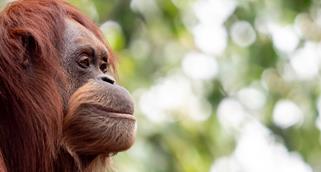Asian Elephant
The Asian Elephant is a fascinating animal that was once widespread throughout Asia. However, loss of habitat and poaching has forced remaining populations into heavily forested, inaccessible regions.
Asian Elephants can be found in Sri Lanka, Laos, Thailand, Burma, China, Malaysia, India, Indonesia, Vietnam and Cambodia. There are fewer than 53,000 remaining throughout Asia, and the wild population is decreasing.
Melbourne Zoo has welcomed three adorable Asian Elephant calves!
The opportunity for the closely bonded herd to raise three calves simultaneously is the work of Luk Chai, an adult breeding bull who arrived at Melbourne Zoo in December 2020.
While the calves will be born at Melbourne Zoo, they will join the whole herd in moving to Werribee Open Range Zoo in 2024, following completion of an $88 million expansion funded by the Victorian Government. The new space at Werribee Open Range Zoo will provide the herd with a state-of-the-art home and 21 hectares to roam.
We are continuing our partnership with Fauna and Flora International, which aims to understand the threats to Asian Elephants by surveying and researching wild populations in northern Vietnam, so we can support these gentle giants in the wild.
As the herd grows, we would like to thank our experienced keepers and veterinary teams who are working around-the-clock to ensure the expectant mothers remain healthy and comfortable
At Melbourne Zoo, their home is the award-winning Trail of the Elephants, which allows the elephants space to roam and forage and move between different paddocks as they please.
Elephants are matriarchal, meaning the females live in a herd together while the males live by themselves or in small bachelor groups in the wild. We replicate this natural behaviour at Melbourne Zoo with our multi-generational, cohesive, female herd.
Multiple pregnancies have been achieved since Melbourne Zoo established the Cooperative Conservation Breeding Program upon the arrival of three young elephant cows from Thailand, in November 2006.
Melbourne Zoo’s first-ever calf, Mali, was the first female elephant born in Australia.
In the wild, the Asian Elephant eats leaves, flowers, fruits, shrubs, grasses and roots. At Melbourne Zoo, the herd’s diet is mostly hay and lucerne, along with treats of carrots, apples, bread, sugar cane, bamboo, and leafy branches. The Zoo’s elephants are contributors to the compost production at Melbourne Zoo, which is sold in garden centres as Zoo Gro.
Elephants, hormones and more!
You may already know that elephants are very intelligent and complex animals. They are deep thinkers that are tuned in to the world around them and can respond to even the slightest change in their environment.
When you're at Melbourne Zoo, there are two interesting occasions that you may observe a change in the behaviour of our bull elephant, Luk Chai: when he detects a female elephant is in oestrus or when he is in musth.
What is oestrus?
Oestrus is the period around the time when a female elephant can fall pregnant. It happens roughly every three months and is caused by a hormonal change in the female elephant. Bull elephants like Luk Chai have an incredible ability to detect a female elephant who is in oestrus. They do this by examining the females with their keen sense of smell.
When Luk Chai is detecting that one of our females is in oestrus, there are some occasions when we are required to keep him separated from the females for breeding management reasons (we have made a commitment to ensure we breed carefully, responsibly and sustainably).
This can cause some frustration for Luk Chai but we are passionate about supporting the complex and fascinating social needs of both cows and bulls so our keepers create variability and opportunities for Luk Chai to move around all the habitats and explore.
What is musth?
Bull elephants enter a hormonal cycle called ‘musth’ which is accompanied by a higher level of reproductive hormones and a change in behaviour.
A typical characteristic you can observe is the draining of fluid from their temporal glands on the side of their head and dribbling of urine - nice, huh? It’s natural for them to become more unpredictable and aggressive during this time. They may have a reduced appetite and sometimes are not easily distracted from their focus on the other elephants.
When a female is in oestrus or when Luk Chai is in musth, there are some occasions where Luk Chai needs to be kept separate from the other elephants during this time and this may cause some obvious frustration but we are passionate about supporting the complex and fascinating social needs of both cows and bulls, and ensuring that the safety of all individuals is considered. Our keepers create variability and opportunities for all the elephants to move around all the habitats and explore, as well as social time when appropriate.
Each time you visit, you are likely to see the elephants doing something different!
Zoos Victoria has an international partnership with Fauna and Flora International (FFI), who met a rigorous selection criteria based on their ability to demonstrate measurable outcomes for humans and wildlife alike through their work. FFI is embarking on extensive work in the field to help better understand human-elephant conflict. They will also survey across Nghe An Province, of which Pu Mat National Park is part, to establish known numbers of elephants in this wild region, which is one of the three priorities in Vietnam’s national elephant strategy. In addition to this partnership, our team of welfare specialists and elephant care experts have significantly advanced knowledge in the care of this species and future partnerships are being explored for us to have the opportunity to share these insights and resources, in order to improve welfare standards for elephants in human care globally.
Elephants are a particularly special endangered species because they have the ability to touch the hearts of humans of all ages, which helps people connect with this species and helps to protect them. Our elephants are also part of a regional breeding program that helps conserve a set of diverse genetics should the need arise – although we hope it never does – that elephants become extinct in the wild and need to be repopulated using zoo genetics, similar to the situation with the Asian Wild Horse in Mongolia in the 1990s where zoo genetics were able to bring this species back from being extinct in the wild. In the meantime, please keep putting pressure on manufacturers to stop using unsustainable palm oil practices by only buying products with 100% Certified Sustainable Palm Oil or no palm oil.
Melbourne Zoo Elephant Browse Program
The Elephant Browse Program is aimed to enhance our elephants natural behaviours and encourage foraging in our growing herd. It is designed for members of our local community to provide approved species of browse from their gardens to our elephants. If you would like to get involved or would like more information about this program, find out more in the brochure below. For any questions you may have, please contact elephantbrowse@zoo.org.au.
Meet the animals
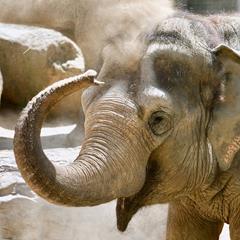
Melbourne Zoo's oldest elephant, Mek Kapah arrived at the Zoo on May 11 1978 from Malaysia. She is the matriarch (leader) of the herd.
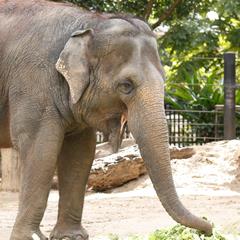
Kulab arrived on November 5 2006 from Thailand. In 2010, she gave birth to Melbourne Zoo's first male calf, Ongard, who is now part of an breeding program in America.
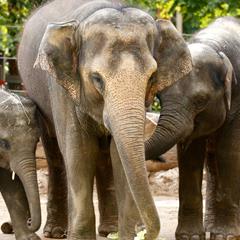
Dokkoon arrived at Melbourne Zoo on November 5 2006 from Thailand. In 2010 she gave birth to Melbourne Zoo's first elephant calf, Mali.
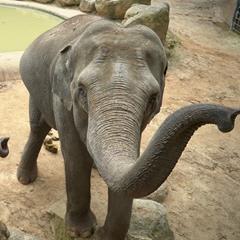
Num-Oi arrived at Melbourne Zoo on November 5 2006 from Thailand. You can pick Num-Oi apart from the other elephants in the herd by her distended stomach which is a result of her diet before arriving at Melbourne Zoo from Thailand. Num-Oi is mum to Kati, born in 2023.
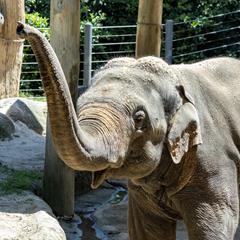
Born 4 July 2009 at Taronga Zoo Sydney, Luk Chai, meaning "male child" or "son" in Thai, is an energetic, inquisitive and confident male elephant who loves a splash around in the pool. He arrived at Melbourne Zoo in December 2020 for social and breeding opportunities with our female herd and has fathered three calves, Aiyara, Roi-Yim and Kati.
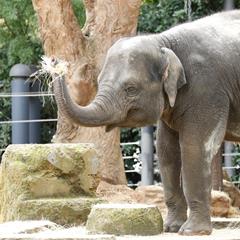
Born 16 January 2010, Mali was the first elephant to be born at Melbourne Zoo. She is mum to Roi-Yim and a mini-matriarch in the making. Like her late father Bong Su, Mali has a zig-zag tail that makes her easy to spot in the herd. Mali means 'jasmine' in Thai.
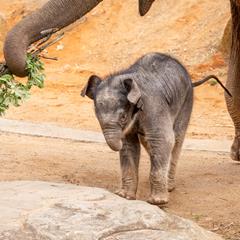
Dokkoon's gorgeous, female calf has been named Aiyara, as voted by our zoo members and donors. Aiyara [pronounced: eye-are-a], means Elephant, a symbol of loyalty, friendliness, good fortune and happiness.
Mother: Dokkoon
Father: Luk Chai
Born: Wednesday 16 November 2022
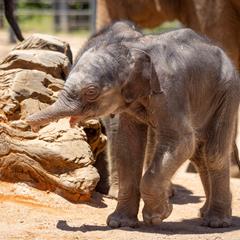
Mali's gorgeous, male calf has been named Roi-Yim, as voted by the public. Roi-Yim [pronounced: roy-yim], means Smile, representing Thailand as the Land of Smiles.
Mother: Mali
Father: Luk Chai
Born: Friday 25 November 2022
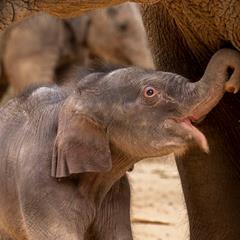
Num-Oi's gorgeous, female calf has been named Kati, as voted by the public. Kati [pronounced: car-tee], means Coconut Milk, an ingredient commonly used in Thai cooking.
Mother: Num-Oi
Father: Luk Chai
Born: Sunday, 1 January 2023

